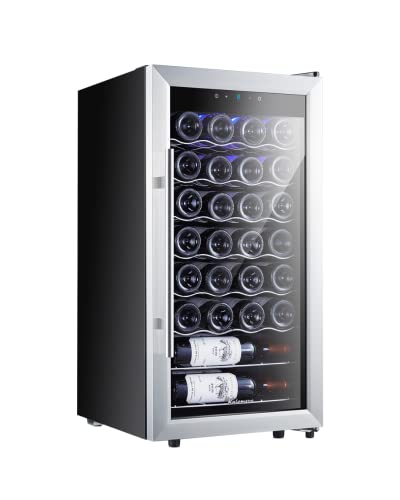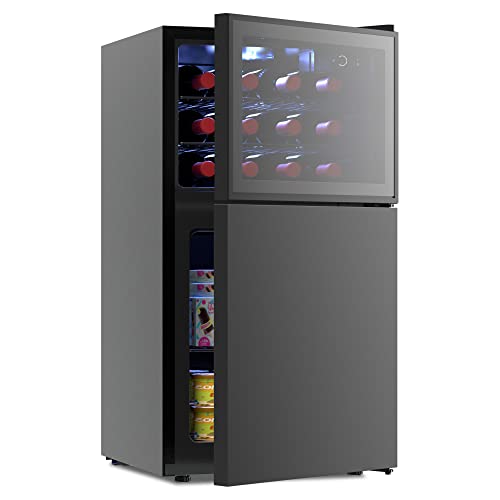You'll Never Guess This Wine Refrigerator Built In's Benefits
페이지 정보
작성자 Bell 댓글 0건 조회 20회 작성일 24-09-03 05:41본문
 Energy Efficient Wine Storage With a Wine Refrigerator Built in
Energy Efficient Wine Storage With a Wine Refrigerator Built inThis efficient built-in wine refrigerator allows you to store and serve your wine at the ideal temperature. You can store red and white wine separately in two temperature zones to preserve their full flavour.
 These units are designed to blend seamlessly into your cabinetry and can be positioned beneath countertops to give you an easy access to a refreshing Riesling glass after dinner. They do require ventilation and adequate clearance to dissipate heat effectively.
These units are designed to blend seamlessly into your cabinetry and can be positioned beneath countertops to give you an easy access to a refreshing Riesling glass after dinner. They do require ventilation and adequate clearance to dissipate heat effectively.Size and Capacity
A wine refrigerator that is built-in provides a sleek and stylish alternative to large freestanding units. These wine coolers are built with front vents and can be hidden into cabinets or under counters to create a seamless appearance. They also offer more flexible storage options and allow you to change from cold to wine drinks.
These wine refrigerators can accommodate up to 368 bottles and are perfect for serious collectors who have an extensive collection. These units are designed to ensure the safety of your wine for a long period of time by providing ample storage space and precise climate control. These units are great for basements, garages, or unconditioned areas in which a more durable storage space is required.
The capacity for cooling wine refrigerators is typically measured by the number of standard Bordeaux-style bottles it can hold. However, you must take into account whether your wine collection includes different sizes of bottles, such as Burgundy or Champagne. This will affect your capacity requirements, as these bottles need more space than a Bordeaux standard bottle. Some wine fridges have adjustable shelves to accommodate different bottle sizes.
In addition to the dimensions of your wine fridge, you'll have to consider where you're going to place it. If you're looking to build it into existing cabinetry, it's important to remember that you'll need enough space on the right and left side of the unit as in addition to six inches of clearance at the back. This is so that the heat emitted by the wine fridge will be able to escape without restriction and avoid overheating.
Think about installing one of these top rated wine refrigerators-of-the-line wine fridges to your kitchen if you want to invest in the most expensive model that comes with an exquisite stainless-looking finish. These models will bring a touch of luxury to your home thanks to their elegant and stylish door designs. They are also available with larger capacities and are ideal for those who love hosting large parties and gatherings. These wine refrigerators have various features, including dual-zone cooling UV protection and many other options.
Ventilation
If a wine refrigerator is not properly ventilated hot air can build up and cause the appliance to overheat. Ventilation is important because it helps the cooler keep a constant humidity and temperature as well as preventing fluctuations in temperature that could damage the wine bottles or alter the flavor of the wine. To make sure that your wine refrigerator is equipped with the proper ventilation be sure to check it after it has been in operation for a short period of time. If the fridge is cool to the touch, then it has adequate ventilation.
Most wine fridges come with an internal temperature sensor that monitors the temperature of the cooler and alerts you when it is out of range. Some models have dual temperature-controlled zones to allow you to store different types of wines at ideal serving temperatures.
The ideal temperature for wine storage is between 55 and 66 degrees Fahrenheit. This will prevent the development of cork rot and other issues that can harm your valuable collection. Some models come with a lamp that will light up when the temperature inside is below the desired temperature.
A built-in wine fridge could be the best option for your collection, based on your storage requirements. They can be placed seamlessly beneath countertops in kitchens or in bar areas to offer guests with an easy access. Some models feature front vents so they can be installed close to your cabinets for a sleek appearance.
In order to install a wine chiller fridge refrigerator, it is necessary to take care when measuring the space and take into account the cabinet's width. The fridge should be at least a few inches away from the wall on all sides to permit proper ventilation. If a wine refrigerator is pushed against a wall or a cabinet, it may block the vents and block heat from escaping. Freestanding wine fridges have vents on the side or back to effectively disperse heat.
Installation
A wine fridge built-in can be a stylish and useful addition to your bar. When you are deciding on the best location for your new appliance you should keep a few things in mind.
Make sure that the cooler you purchase is equipped with adequate ventilation. If a wine refrigerator is not properly ventilated, it could overheat and ultimately reduce its lifespan.
In addition, you should keep your wine fridge out of direct sunlight or other heat sources. This will shield your collection against the harmful ultraviolet rays emitted by the sun and let it effectively cool down.
Finally, ensure that your wine refrigerator isn't too close to a appliance that produces heat, like a dishwasher. This could lead to your wine becoming damaged or experiencing unpredictable temperature fluctuations.
Wine refrigerators come in two types including freestanding and built-in. While freestanding wine refrigerators are more flexible in terms of installation options, built-in units offer a seamless integration into kitchen cabinets. Both are available in a variety of bottle capacities and styles, meaning you can find the perfect design for your home.
In order to ensure your new wine fridge can effectively ventilate, measure the space where you intend to put it. For ventilation, you should leave a minimum of an inch around the fridge. Also, make sure that the door is fully open. If it cannot be opened, the racks within are difficult to reach.
Certain models could also have particular temperature preferences. Certain wine refrigerators can store red wines at 55°F for optimal serving, while others are designed for long-term storage. It is possible to invest in a dual zone wine fridge in accordance with your needs. This allows you to keep wines that are stored for a long time chilled and serve chilled drinks in the other zone.
If you're planning to install a Wine Refrigerator Built In - Trade-Britanica.Trade - it, make sure you've read the manufacturer's instructions carefully to ensure that your new cooler is correctly installed. It is recommended to wait a few hours after bringing it in before turning it on to let the coolant settle.
Energy Efficiency
In a time when energy is expensive, it's crucial to consider the energy consumption of appliances. When buying a built in wine fridge, look for models with an energy efficiency rating or Energy Star certification. This means that the wine refrigerator is built with the latest cooling technology, and has insulation to conserve energy.
A wine refrigerator has to cool the entire interior as well as the bottles kept inside. A larger wine refrigerator with a larger capacity for bottles will use more energy than a smaller model. Also, the ambient temperature of the room could influence the energy consumption of the fridge because it is working harder to keep an interior temperature that is cooler.
To cut down on the amount of energy consumed by your wine fridge, ensure that it's always filled with wine. It might seem counterintuitive, but a wine refrigerator that is filled with sealed and cold bottles won't need to work more to keep its temperature. Also, keeping the shelves and bottles set properly can help your wine fridge operate more efficiently. If you arrange your bottles horizontally, they'll cool more quickly than if you arrange them on their sides.
Another way to cut down on the energy consumption of your wine refrigerator tall fridge is to choose a new model that has the latest cooling technology. The latest models are usually more efficient than older wine fridges, and could save you up to PS100 per year in energy costs.
When you are looking for a new wine cooler fridge fridge, select one with a low-energy compressor cooling system. This type of fridge uses less energy and is more environmentally friendly than a wine fridge with a higher-energy compressor system. Consider a thermoelectric fridge. These wine coolers cool the interior using the Peltier-effect, which consumes considerably less energy than compressor-based units. They are more sensitive to ambient temperatures and require more regular maintenance. Choose a brand that has an established reputation for making top-quality, reliable wine refrigerators. They will likely produce a refrigerator with an energy-efficient cooling system and quiet operation.
- 이전글11 Ways To Completely Revamp Your Program Car Key 24.09.03
- 다음글f1 로 뭉친다. tvN 새 월화드라마 ‘가석방 심사 24.09.03
댓글목록
등록된 댓글이 없습니다.
